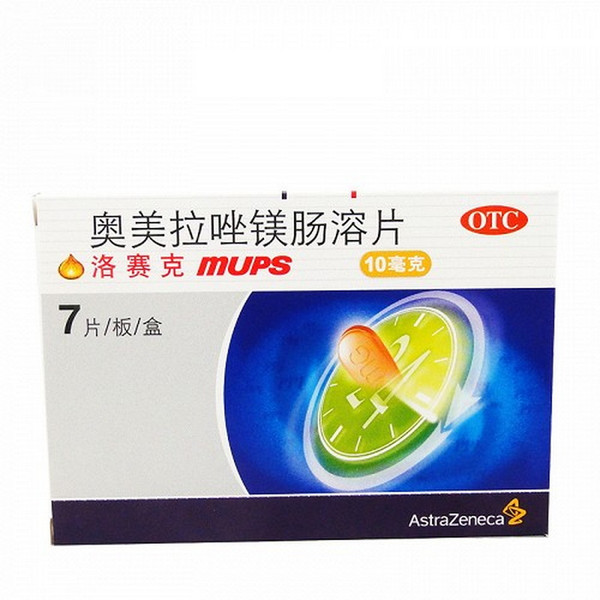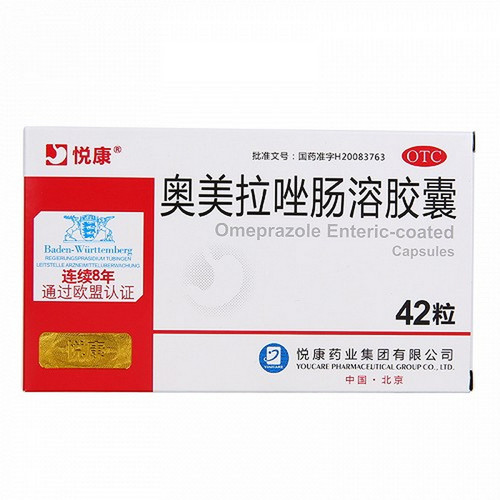Product Overview
[Drug Name]
Generic Name: Omeprazole Magnesium Enteric-Coated Tablets
Trade Name: Losec Omeprazole Magnesium Enteric-Coated Tablets 10mg*7 Tablets
Pinyin Full Code: LuoSaiKe AoMeiLaZuoMeiChangRongPian 10mg*7 Tablets
[Main Ingredients]
The main ingredient of this product is omeprazole magnesium.
[Properties]
This product is a light pink (10mg) or pink (20mg) film-coated tablet.
[Indications/Main Functions]
Treatment of duodenal ulcers, gastric ulcers, and reflux esophagitis; used in combination with antibiotics for the treatment of duodenal ulcers caused by Helicobacter pylori; treatment of peptic ulcers or gastroduodenal erosions associated with nonsteroidal anti-inflammatory drugs; prevention of peptic ulcers, gastroduodenal erosions, or dyspepsia symptoms caused by nonsteroidal anti-inflammatory drugs; also indicated for the long-term treatment of chronic recurrent peptic ulcers and reflux esophagitis; symptomatic treatment of heartburn and regurgitation in gastroesophageal reflux disease; symptomatic treatment of ulcer-like symptoms and acid-related dyspepsia; and treatment of Zollinger-Ellison syndrome.
[Specifications]
10mg x 7 tablets
[Dosage and Administration]
Swallow the tablet whole with at least half a cup of liquid. Do not chew or crush the tablet. Disperse in water or a slightly acidic liquid (e.g., juice). The dispersion must be consumed within 30 minutes. Duodenal ulcers: The usual dose of this drug is 20 mg once daily. Ulcers typically heal within two weeks. If the initial course of treatment is inconclusive, treatment should be continued for another two weeks. For duodenal ulcers that have not responded to other medications, 40 mg once daily typically cures within four weeks. Treatment can be repeated for recurring cases. Helicobacter pylori eradication: Triple therapy: This drug 20 mg, amoxicillin 1000 mg, and clarithromycin 500 mg, all twice daily for one week, or this drug 20 mg, clarithromycin 250 mg, and metronidazole 400 mg, all twice daily for one week. Dual therapy: This drug 40 mg once daily and clarithromycin 500 mg three times daily for two weeks. Or this drug 20 mg and amoxicillin 750-1000 mg, all twice daily for two weeks. To ensure cure, refer to the recommended dosages for duodenal ulcers. For nonsteroidal anti-inflammatory drug-associated duodenal ulcers and duodenal erosions, with or without concomitant NSAIDs: The usual dose is 20 mg once daily. Healing usually occurs within four weeks. If the initial course of treatment is inconclusive, treatment should be continued for another four weeks. For the prevention of nonsteroidal anti-inflammatory drug-associated duodenal ulcers, duodenal erosions, or dyspepsia symptoms: The usual dose is 20 mg once daily. To prevent recurrence of recurrent duodenal ulcers that are refractory to Helicobacter pylori eradication therapy, the dose can be individually adjusted based on disease severity. Efficacy is dose-dependent. The usual dose is 20 mg once daily. For some patients, 10 mg daily may be sufficient; if this dose is ineffective, it can be increased to 40 mg. For gastric ulcers: The usual dose is 20 mg once daily. Healing usually occurs within four weeks. If complete healing is not achieved after the initial course of treatment, treatment should be continued for another four weeks. For other patients with gastric ulcers that do not respond to treatment, 40 mg of this drug can be given once daily, which usually heals within eight weeks. Recurring cases can be treated repeatedly. For long-term treatment of gastric ulcers, take 20 mg of this product once a day. If treatment fails, the dose can be increased to 40 mg once a day. (For other details, see the instructions.)
[Adverse Reactions]
In global clinical trials, 3,096 patients (2,631 of whom were from double-blind or open-label, international, multicenter studies) were exposed to omeprazole. Adverse reactions occurring in 2% or more of patients included headache (6.9%), abdominal pain (5.2%), nausea (4.0%), diarrhea (3.7%), vomiting (3.2%), and flatulence (2.7%). Adverse reactions occurring in 1% or more of patients included acid reflux (1.9%), upper respiratory tract infection (1.9%), constipation (1.5%), dizziness (1.5%), rash (1.5%), fatigue (1.3%), back pain (1.1%), and cough (1.1%). The following adverse reactions have been reported during post-marketing use of this product. Because these adverse reactions are reported voluntarily in an unknown number of patients, it is difficult to estimate their incidence or establish a causal relationship to drug exposure. The following are listed by organ system: Systemic disorders: Hypersensitivity reactions including anaphylaxis, anaphylactic shock, angioedema, bronchospasm, interstitial nephritis, urticaria, fever, pain, fatigue, and malaise; Cardiovascular system: Chest pain, angina, tachycardia, bradycardia, palpitations, increased blood pressure, and peripheral edema; Endocrine system: Gynecomastia; Gastrointestinal system: Pancreatitis (some cases can be fatal), anorexia, irritable bowel, discolored stool, esophageal candidiasis, tongue mucosal atrophy, stomatitis, dry mouth, abdominal distension, and microscopic colitis. Fundic gland polyps have been very rarely observed during omeprazole treatment. These polyps are benign and reversible after discontinuation of treatment. Gastroduodenal carcinoid tumors have been reported in patients with Zollinger-Ellison syndrome during long-term omeprazole treatment; this finding is believed to be related to the underlying disease. Hepatobiliary System: Liver failure (some fatal), hepatic necrosis (some fatal), hepatic encephalopathy, hepatocellular disease, cholestasis, mixed hepatitis, jaundice, elevated liver function tests (ALT, AST, GGT, alkaline phosphatase and bilirubin); Infections: Clostridium difficile diarrhea; Metabolic Disorders and Malnutrition: Hypoglycemia, hypomagnesemia, hypocalcemia, hypokalemia, hyponatremia, weight gain; Musculoskeletal System: Myasthenia, myalgia, muscle cramps, joint pain, foot pain, fractures; Neurological/Psychiatric Disorders: Depression, agitation, aggressiveness, hallucinations, confusion, insomnia, nervousness, apathy, drowsiness, anxiety, abnormal dreams, tremor, paresthesia, dizziness, taste disturbances; Respiratory System: Epistaxis, sore throat; Skin and Subcutaneous Tissue: Subacute Acute cutaneous lupus erythematosus, toxic epidermal necrolysis (some cases are fatal), Stevens-Johnson syndrome, erythema multiforme, photosensitivity, urticaria, rash, dermatitis, pruritus, petechiae, purpura, alopecia, dry skin, hyperhidrosis; Ear and Labyrinth: tinnitus; Eye: optic atrophy, anterior ischemic optic neuropathy, optic neuritis, dry eye syndrome, eye irritation, blurred vision, diplopia; Genitourinary: interstitial nephritis, hematuria, proteinuria, increased serum creatinine, microscopic pyuria, urinary tract infection, glycosuria, frequent urination, testicular pain; Blood and Lymphatic: agranulocytosis (some cases are fatal), hemolytic anemia, pancytopenia, neutropenia, anemia, thrombocytopenia, leukopenia, leukocytosis. Hypomagnesemia (hypomagnesemia may also be associated with hypokalemia; severe hypomagnesemia may lead to hypocalcemia); hip, wrist, or spinal fractures; Clostridium difficile-associated diarrhea.
[Contraindications]
1. This product is contraindicated in patients with a known hypersensitivity to omeprazole, other benzimidazoles, or any other component of this product. Hypersensitivity reactions may include anaphylaxis, anaphylactic shock, angioedema, bronchospasm, interstitial nephritis, and urticaria. 2. As with other proton pump inhibitors, omeprazole should not be used concomitantly with nelfinavir.
[Precautions]
1. Gastric Malignancy: When gastric ulcer is suspected or confirmed and alarm symptoms (such as unresponsive, significant weight loss, recurrent vomiting, dysphagia, hematemesis, or melena) occur, malignancy should be ruled out first, as treatment may mask symptoms and delay diagnosis. 2. Atrophic Gastritis: Atrophic gastritis may occasionally be observed on gastric corpus biopsy in patients receiving long-term omeprazole therapy. 3. Acute Interstitial Gastritis: Acute interstitial gastritis has been observed in patients taking proton pump inhibitors (PPs), including this product. Acute interstitial gastritis may occur at any time during PPI treatment and is usually caused by an idiopathic hypersensitivity reaction. If acute interstitial gastritis occurs, this product should be discontinued (see [Contraindications]). 4. Cyanocobalamin (Vitamin B12) Deficiency: Long-term (e.g., more than 3 years) daily treatment with acid-suppressing medications may lead to hypochlorhydria or achlorhydria, which in turn may cause vitamin B12 malabsorption. There have been rare reports of cyanocobalamin deficiency associated with acid-suppressing therapy. This diagnosis should be considered if clinical symptoms consistent with cyanocobalamin deficiency are observed. 5. Clostridium difficile Diarrhea: Published observational studies suggest that PPI treatment may increase the risk of Clostridium difficile diarrhea, particularly in hospitalized patients. This diagnosis should be considered if diarrhea does not improve (see [Adverse Reactions]). Patients should receive the lowest dose and shortest duration of PPI therapy appropriate for their medical condition. Pathological cases of Clostridium difficile diarrhea have been reported with the use of nearly all antimicrobial agents. For more information on antibacterial drugs used in combination with this product (such as clarithromycin and amoxicillin), please refer to the relevant product inserts. 6. Interactions with Clopidogrel: Avoid co-administration of this product with clopidogrel. Clopidogrel is a prodrug whose active metabolite inhibits platelet aggregation. When co-administered with drugs such as omeprazole, which inhibits CYP2C19 activity, this may affect the metabolism of clopidogrel to its active metabolite. Co-administration of clopidogrel and 80 mg of omeprazole may reduce the pharmacological activity of clopidogrel, even if the two are administered 12 hours apart. When using this product, consideration should be given to alternative antiplatelet therapy (see [Drug Interactions]). 7. Fractures: Multiple published observational studies have shown that PPI therapy may increase the risk of osteoporosis-related fractures (hip, wrist, or spine). Patients receiving high-dose (defined as multiple daily doses) and long-term (one year or longer) PPI therapy have an increased risk of fractures. Patients should receive the lowest dose and shortest duration of PP therapy based on their medical condition. Patients at risk for osteoporosis-related fractures should be managed according to relevant treatment guidelines. 8. Hypomagnesemia: Rare cases of asymptomatic and symptomatic hypomagnesemia have been reported in patients receiving PPI therapy for at least 3 months (mostly after 1 year of treatment). Serious adverse events include tetany, cardiac arrhythmias, and seizures. Most patients require magnesium supplementation and discontinuation of PPI therapy to correct hypomagnesemia. Regular monitoring of serum magnesium levels should be considered if prolonged PPI therapy is anticipated or if concomitant medications such as digoxin or other drugs that may cause hypomagnesemia (e.g., diuretics) are used. 9. Concomitant use of St. John's wort or rifampicin with drugs that induce CYP2C19 or CYP3A4 (e.g., St. John's wort or rifampicin) can significantly reduce omeprazole plasma concentrations. Coadministration of this product with St. John's wort or rifampicin should be avoided. 10. Interactions with Diagnostic Tests for Neuroendocrine Tumors: Serum chromogranin A (CgA) levels can increase secondary to drug-induced decreases in gastric acid. Elevated CgA levels can lead to false-positive results in diagnostic tests for neuroendocrine tumors. Healthcare professionals should withhold olamezole for at least 14 days before assessing blood CgA levels. If the initial CgA level is elevated, rechecking should be considered. Because normal reference values may vary between laboratories, serial testing (e.g., monitoring) should be performed in the same laboratory. 11. Use of Methotrexate: Literature suggests that the concomitant use of PPIs and methotrexate (primarily high-dose; see methotrexate package insert) may increase and prolong the blood concentrations of methotrexate and/or its metabolites, potentially leading to methotrexate toxicity. Some patients should consider discontinuing PPIs when taking high-dose methotrexate (see [Drug Interactions]). 12. Subacute Cutaneous Lupus Erythematosus (SCLE): Only very rare cases of SCLE have been associated with proton pump inhibitors. If skin lesions occur, especially in areas exposed to the sun, and are accompanied by joint pain, patients should seek medical help promptly, and professional medical personnel should consider stopping taking Losec. Patients who have used proton pump inhibitors and have been treated for subacute cutaneous lupus erythematosus may increase the risk of subacute cutaneous lupus erythematosus if they take other PPIs again. 13. This product contains sucrose. Patients with rare genetic diseases such as fructose intolerance, glucose-galactose malabsorption, or sucrase-isomaltase deficiency should not take this product. 14. Treatment with proton pump inhibitors may result in a slightly increased risk of gastrointestinal infections, such as Salmonella and Campylobacter infections. 15. Patients who take this product for a long time, especially those who use it for more than 1 year, should be monitored regularly. 16. Patients with long-term and recurring symptoms of indigestion and heartburn should seek medical attention regularly. 17. Patients should consult a doctor if they: · Previous history of gastric ulcer or gastrointestinal surgery · Continuous treatment for indigestion or heartburn for more than 4 weeks · Jaundice or severe liver disease · Age 55 or older · New or recent changes in symptoms









